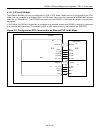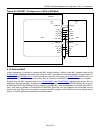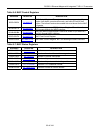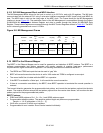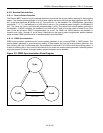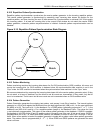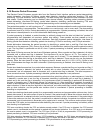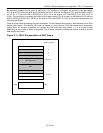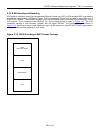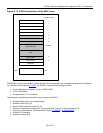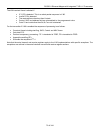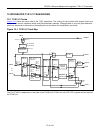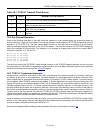
DS33R11 Ethernet Mapper with Integrated T1/E1/J1 Transceiver
66 of 344
9.18 Receive Packet Processor
The Receive Packet Processor accepts data from the Receive Serial Interface performs packet descrambling,
packet delineation, inter-frame fill filtering, packet abort detection, destuffing, packet size checking, FCS error
monitoring, FCS byte extraction, and bit reordering. The data coming from the Receive Serial Interface is a serial
data stream. Packet processing can be disabled (clear channel enable). Disabling packet processing disables
packet delineation, inter-frame fill filtering, packet abort detection, destuffing, packet size checking, FCS error
monitoring, and FCS byte extraction. Only packet descrambling and bit reordering are not disabled.
The packet descrambler is a self-synchronous x
43
+ 1 descrambler that descrambles the entire packet data stream.
Packet descrambling is programmable. The descrambler runs continuously, and is never reset. The descrambling
is performed one bit at a time. Packet descrambling is programmable. If packet processing is disabled, the serial
data stream is demultiplexed in to an 8-bit data stream before being passed on.
If packet processing is disabled, a packet boundary is arbitrarily chosen and the data is divided into "packets" of
programmable size (dependent on maximum packet size setting). These packets are then passed on to bit
reordering with packet start and packet end indications. Data then bypasses packet delineation, inter-frame fill
filtering, packet abort detection, destuffing, packet size checking, FCS error monitoring, and FCS byte extraction.
Packet delineation determines the packet boundary by identifying a packet start or end flag. Each time slot is
checked for a flag sequence (7Eh). Once a flag is found, it is identified as a start/end flag and the packet boundary
is set. The flag check is performed one bit at a time. If packet processing is disabled, packet delineation is not
performed.
Inter-frame fill filtering removes the inter-frame fill between packets. When a packet end flag is detected, all data is
discarded until a packet start flag is detected. The inter-frame fill can be flags or all '1's. The number of '1's
between flags does not need to be an integer number of bytes, and if at least 7 '1's are detected in the first 16 bits
after a flag, all data after the flag is discarded until a start flag is detected. There may be only one flag between
packets. When the inter-frame fill is flags, the flags may have a shared zero (011111101111110). If there is less
than 16 bits between two flags, the data is discarded. If packet processing is disabled, inter-frame fill filtering is not
performed.
Packet abort detection searches for a packet abort sequence. Between a packet start flag and a packet end flag, if
an abort sequence is detected, the packet is marked with an abort indication, the aborted packet count is
incremented, and all subsequent data is discarded until a packet start flag is detected. The abort sequence is
seven consecutive ones. If packet processing is disabled, packet abort detection is not performed.
Destuffing removes the extra data inserted to prevent data from mimicking a flag or an abort sequence. A start flag
is detected, a packet start is set, the flag is discarded, destuffing is performed until an end flag is detected, a
packet end is set, and the flag is discarded. In bit synchronous mode, bit destuffing is performed. Bit destuffing
consists of discarding any '0' that directly follows five contiguous '1's. After destuffing is completed, the serial bit
stream is demultiplexed into an 8-bit parallel data stream and passed on with packet start, packet end, and packet
abort indications. If there is less than eight bits in the last byte, an invalid packet flag is raised, the packet is tagged
with an abort indication, and the packet size violation count is incremented. If packet processing is disabled,
destuffing is not performed.
Packet size checking checks each packet for a programmable maximum and programmable minimum size. As the
packet data comes in, the total number of bytes is counted. If the packet length is below the minimum size limit, the
packet is marked with an aborted indication, and the packet size violation count is incremented. If the packet length
is above the maximum size limit, the packet is marked with an aborted indication, the packet size violation count is
incremented, and all packet data is discarded until a packet start is received. The minimum and maximum lengths
include the FCS bytes, and are determined after destuffing has occurred. If packet processing is disabled, packet
size checking is not performed.
FCS error monitoring checks the FCS and aborts errored packets. If an FCS error is detected, the FCS errored
packet count is incremented and the packet is marked with an aborted indication. If an FCS error is not detected,
the receive packet count is incremented. The FCS type (16-bit or 32-bit) is programmable. If FCS processing or
packet processing is disabled, FCS error monitoring is not performed.
FCS byte extraction discards the FCS bytes. If FCS extraction is enabled, the FCS bytes are extracted from the
packet and discarded. If FCS extraction is disabled, the FCS bytes are stored in the receive FIFO with the packet.
If FCS processing or packet processing is disabled, FCS byte extraction is not performed.



